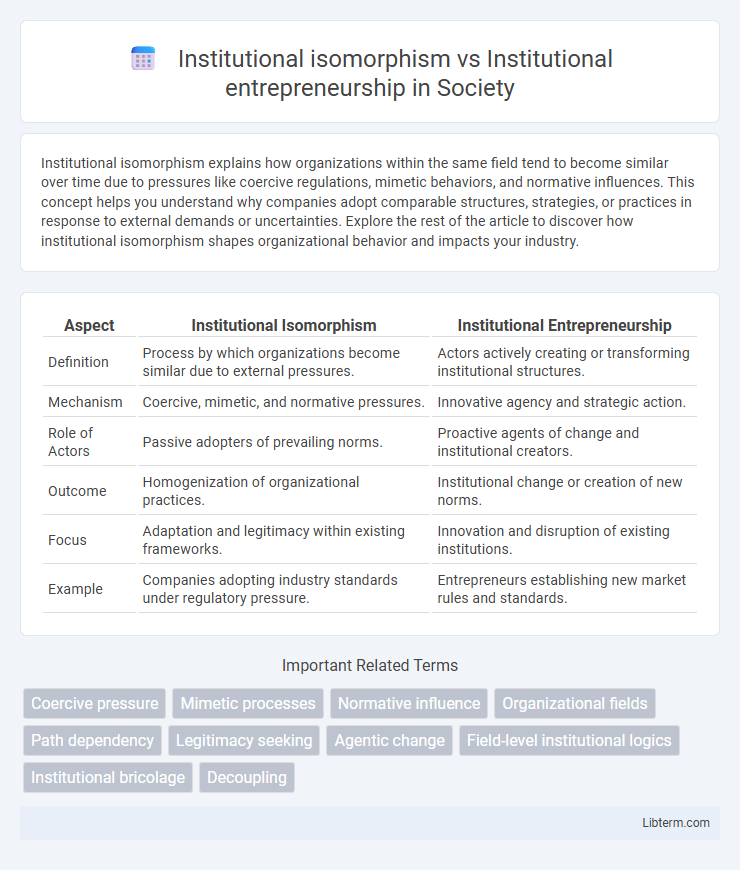Institutional isomorphism explains how organizations within the same field tend to become similar over time due to pressures like coercive regulations, mimetic behaviors, and normative influences. This concept helps you understand why companies adopt comparable structures, strategies, or practices in response to external demands or uncertainties. Explore the rest of the article to discover how institutional isomorphism shapes organizational behavior and impacts your industry.
Table of Comparison
| Aspect | Institutional Isomorphism | Institutional Entrepreneurship |
|---|---|---|
| Definition | Process by which organizations become similar due to external pressures. | Actors actively creating or transforming institutional structures. |
| Mechanism | Coercive, mimetic, and normative pressures. | Innovative agency and strategic action. |
| Role of Actors | Passive adopters of prevailing norms. | Proactive agents of change and institutional creators. |
| Outcome | Homogenization of organizational practices. | Institutional change or creation of new norms. |
| Focus | Adaptation and legitimacy within existing frameworks. | Innovation and disruption of existing institutions. |
| Example | Companies adopting industry standards under regulatory pressure. | Entrepreneurs establishing new market rules and standards. |
Understanding Institutional Isomorphism
Institutional isomorphism explains how organizations within the same field tend to become similar over time due to coercive, mimetic, and normative pressures. This process fosters homogeneity as firms adopt standardized structures, practices, and policies to gain legitimacy and reduce uncertainty. Understanding institutional isomorphism is crucial for analyzing how external forces shape organizational behavior and constrain innovation within industries.
Defining Institutional Entrepreneurship
Institutional entrepreneurship involves actors who leverage resources and strategic actions to create, transform, or disrupt institutional fields, driving significant organizational or social change. Unlike institutional isomorphism, which emphasizes conformity and homogeneity within organizations due to coercive, mimetic, or normative pressures, institutional entrepreneurship highlights proactive agency to initiate novel institutional arrangements. These entrepreneurs possess the capacity to mobilize support, challenge existing norms, and foster innovation in institutional environments.
Core Differences Between Isomorphism and Entrepreneurship
Institutional isomorphism refers to the process by which organizations within a field become increasingly similar due to coercive, mimetic, or normative pressures, leading to conformity and stability. Institutional entrepreneurship involves actors who leverage resources and strategic actions to create or transform institutions, driving change and innovation within established structures. The core difference lies in isomorphism emphasizing conformity to existing norms, while entrepreneurship highlights active agency in institutional change.
Mechanisms of Institutional Isomorphism
Mechanisms of institutional isomorphism include coercive, mimetic, and normative pressures that drive organizations to adopt similar structures and practices for legitimacy and survival. Coercive isomorphism arises from formal and informal pressures exerted by other organizations or regulatory bodies, mimetic isomorphism occurs when organizations imitate others during times of uncertainty, and normative isomorphism stems from professionalization and shared norms among practitioners. Institutional entrepreneurship differs by actively leveraging and transforming these mechanisms to create new institutions rather than conforming to existing ones.
Agents and Processes in Institutional Entrepreneurship
Institutional entrepreneurship involves proactive agents who leverage resources and social influence to initiate transformative changes within existing institutional frameworks. These agents disrupt institutional isomorphism, a process where organizations converge toward homogeneity due to coercive, mimetic, and normative pressures. The dynamic processes of institutional entrepreneurship include strategic agency, coalition-building, and framing practices that reshape institutional logics and organizational fields.
The Role of Power and Agency
Institutional isomorphism explains how organizations conform to dominant norms and regulations due to coercive, mimetic, or normative pressures, reflecting limited agency in decision-making. Institutional entrepreneurship emphasizes the capacity of actors with sufficient power and resources to initiate and drive significant changes within institutional fields, challenging the status quo. The role of power and agency differentiates passive adaptation from proactive transformation, highlighting how influential actors mobilize change despite structural constraints.
Organizational Responses to Institutional Pressures
Organizational responses to institutional pressures often manifest through institutional isomorphism, where firms conform to regulatory, normative, and cognitive expectations to gain legitimacy and reduce uncertainty. In contrast, institutional entrepreneurship involves proactive actors who leverage resources and strategic agency to transform or create new institutional norms, challenging the status quo. These divergent responses highlight how organizations either adapt passively by mimicking prevailing industry practices or actively shape institutional environments to achieve competitive advantage.
Case Studies: Isomorphism vs Entrepreneurship in Action
Case studies on institutional isomorphism versus institutional entrepreneurship reveal how organizations either conform to prevailing norms or actively reshape institutional fields. Isomorphic forces drive firms toward homogeneity by mimicking successful models to gain legitimacy, as seen in the adoption of corporate social responsibility practices among multinational corporations. In contrast, entrepreneurial actors initiate transformative change by introducing novel practices or challenging existing power structures, exemplified by fintech startups disrupting traditional banking institutions.
Implications for Organizational Change
Institutional isomorphism drives organizations to conform to prevailing norms and practices, often resulting in homogenization and reduced innovation potential. Institutional entrepreneurship, in contrast, empowers actors within organizations to challenge existing institutional arrangements and introduce novel practices, fostering adaptive and transformative change. Understanding these dynamics is critical for managing organizational change, as balancing conformity pressures with entrepreneurial initiatives enhances long-term competitiveness and resilience.
Future Trends in Institutional Theory
Future trends in institutional theory emphasize the dynamic interplay between institutional isomorphism and institutional entrepreneurship, highlighting how organizations not only conform to prevailing norms but also actively reshape them through innovation and strategic agency. Emerging research explores digital transformation and sustainability as key drivers where institutional entrepreneurs challenge traditional isomorphic pressures by fostering novel practices and institutional fields. This evolving perspective underscores a shift from passive conformity to proactive change-making, repositioning institutions as arenas of ongoing negotiation and adaptation.
Institutional isomorphism Infographic

 libterm.com
libterm.com